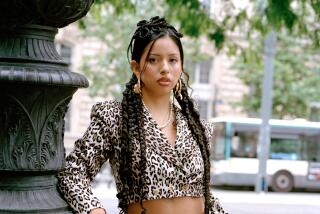Many and Diverse Latin Flavors : Review: Museum of Art brings together conglomeration of works by 49 artists in an exhibit showing the major trends in contemporary Latin American works.
SAN DIEGO — “Latin American Drawings,” which opens today at the San Diego Museum of Art in Balboa Park, is a vast and ambitious show. With about 160 works by 49 artists from 11 Latin American countries and Puerto Rico, the show aims to give a big picture of art that is little-known in the United States.
Through these drawings--a loose term for a variety of works on paper that includes everything from collage, to painted imagery and traditional pencil drawings--we see much of what has long been present in Latin American art: influences of Surrealism, traces of European academicism, satirical political commentary, machismo and some unfettered flights of fancy.
There is very little that is purely pop, and almost nothing that is purely abstract. In that, this generally satisfying show is vastly different from what one would expect of an overlook of contemporary North American art.
This is not a name-brand show. There are no drawings by the bad-boy of Mexico, Jose Luis Cuevas, for example. Nor are there any works by the Colombian master-of-plump-people, Fernando Botero, who now lives in Paris and New York. The presence of such well-known artists might have rounded out this show, giving a sense of context and influence.
But their presence is not really missed. There are others who are almost as well-known here. The painter Claudio Bravo, for example, a Chilean represented by a pair of beautiful academic life drawings, has shown in New York and Europe and in 1985 was included in the renowned “48th Carnegie International” exhibition in Pittsburgh.
This is a fresh picture of living artists, all of whom have long track records in Latin America, and some of whom also are well-known in Europe. And, as hoped, there is much that is extremely impressive here. And, not surprisingly, lots that isn’t.
What is most disappointing, however, is the structure of the show. With so much new information to digest, it would have helped if there were some sense of organization in the installation, whether by theme, medium or even country. Curator Mary Stofflet chose to place the works according to her own aesthetic, and, indeed, the overwhelming number of powerful images do look very good. But she provides no help in the gallery to better understand the meaning and impulses behind these works--and our appreciation of them suffers. Narrative content is extremely important to many of these artists--and we have no clue as to where they are coming from.
We are left, therefore, to judge them only on the basis of our own aesthetic--and, for many of us, that means imposing our own Euro-centric biases. That is a risky notion, given the differences in politics and artistic precedents between North and South America.
A catalogue that accompanies the show includes short but enlightening essays by Shifra M. Goldman, a research associate at the Latin American Center at UCLA; Gloria Zea, director of the Museo de Arte Moderno de Bogota, and Belgica Rodriguez, director of the Museum of Modern Art of Latin America in Washington. But there is not enough substance to make the difference. And no informational brochures are available in the galleries.
In a show that takes pride in introducing new art, such information is sorely missed.
It helps to know, for example that Mexican artist Arnold Belkin’s series of larger-than-life heroic drawings is of a Mexican guerrilla leader Lucio Cabanas, who modeled himself after Ernesto (Che) Guevara. Belkin’s carefully rendered and almost academic mixed-media drawings were based on classified photographs of the gun-clad warrior. They are done on Pre-Colombian style paper made today by the Otomi Indians.
Such political work descends directly from the work of muralist Diego Rivera and his many followers. Cuban Ramon Alejandro’s “Fatum (Destiny),” 1990, with its strange sadomasochistic contraption pinching a papaya, has all the claustrophobic perversity of the work of Frida Kahlo, whose brutally introspective self-portraits have influenced a generation of feminists, and numerous other artists here.
There is a plethora of brutality in this work--Colombian Luis Caballero’s Expressionist, yet anatomically correct, images of wrenchingly intertwined males are done in rust-colored pigments to give the feeling of bloodied battle. Jorge Alvaro’s picture of a group of bald men watching a female contortionist bare her breasts by bending over backward goes even further than the New York underworld pictured so vividly in the 1930s by Reginald Marsh.
And Surrealist-style sci-fi nightmares are perpetuated by numerous artists here, among them Uruguayan Jorge Damiani, Chilean Guillermo Bert and Colombian Alvaro Barrios--though without much new to say.
Among the most peaceful--and intriguing--works are a series of small images of water done in crayon and charcoal by Helen Escobedo of Mexico. The drawings are done on handmade paper mounted, in each case, on a heavy-weave metal screen.
The contrast between the delicate lines of the drawings, the rough texture of the paper and the gnarled web of the screen creates rhythmic progression from fluid to highly structured.
Despite this show’s ups and downs, it is a lesson in diversity and complexity. Its volume is its greatest strength. The artists were selected following suggestions of five advisers: essayists Zea and Rodriguez; Marc Berkowitz, critic, Rio de Janeiro; Jorge Glusberg, director, Centro de Arte y Communicacion, Buenos Aires, and Rafael Squirru, critic, Buenos Aires.
And yet, despite its breadth, it leaves us thirsty for more. More information. More art. More artists.
“Latin American Drawings Today” continues at the San Diego Museum of Art through April 28.
More to Read
The biggest entertainment stories
Get our big stories about Hollywood, film, television, music, arts, culture and more right in your inbox as soon as they publish.
You may occasionally receive promotional content from the Los Angeles Times.










